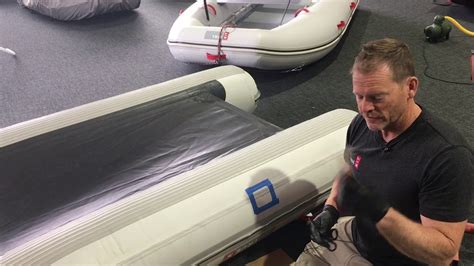How To Repair Rubber Boat
Ronan Farrow
Apr 02, 2025 · 3 min read

Table of Contents
How to Repair a Rubber Boat: A Comprehensive Guide
Maintaining your rubber boat is crucial for ensuring safe and enjoyable excursions on the water. Knowing how to repair common damages will extend its lifespan and prevent costly replacements. This guide will walk you through various repair techniques, helping you tackle punctures, tears, and other common rubber boat problems.
Identifying the Damage
Before you begin any repair, carefully inspect the damage. Knowing the type and extent of the damage will dictate the best repair method. Common issues include:
- Punctures: Small holes caused by sharp objects. These are often the easiest to repair.
- Tears: Larger rips or cuts in the rubber material. These require more extensive patching.
- Wear and Tear: General deterioration of the rubber due to sun exposure, abrasion, or age. This may require a more holistic approach, potentially involving specialized patching compounds.
Essential Repair Materials
Gathering the right materials beforehand ensures a smooth and efficient repair process. You'll likely need:
- Rubber Repair Kit: These kits typically include patches, adhesive, and sandpaper. Choose a kit specifically designed for inflatable boats.
- Clean Rags: For cleaning the damaged area before applying the patch.
- Scissors or Utility Knife: For trimming patches to the appropriate size.
- Pencil or Marker: To outline the patch area.
- Soap and Water: For cleaning and prepping the surface.
- Inflatable Boat Glue: In case the kit glue is insufficient or of poor quality.
- Waterproof Sealant (Optional): For added protection against water ingress, especially for larger tears.
Repairing Punctures
Small punctures are relatively straightforward to repair:
- Clean the Area: Thoroughly clean the punctured area with soap and water, removing any dirt or debris. Allow it to dry completely.
- Apply Adhesive: Apply a thin layer of adhesive to the patch and the surrounding area of the puncture. Follow the instructions on your repair kit.
- Apply Patch: Carefully press the patch firmly onto the punctured area, ensuring complete adhesion. Hold it in place for the recommended time specified on the kit instructions.
- Allow to Dry: Let the adhesive dry completely before inflating the boat.
Repairing Tears
Larger tears require a more involved approach:
- Clean and Prepare: As with punctures, clean the area thoroughly and let it dry completely. For larger tears, you may need to slightly roughen the edges of the tear with fine-grit sandpaper to improve adhesion.
- Apply a Backing Patch (Optional but Recommended): For added strength, consider applying a backing patch to the inside of the boat, directly behind the tear. This provides reinforcement.
- Apply Adhesive and Patch: Apply adhesive to both the tear and the patch, then carefully position the patch over the tear, ensuring full contact.
- Secure the Patch: Use strong tape or clamps to secure the patch and prevent air leakage while the adhesive cures. Follow the curing time recommended on your adhesive packaging.
- Additional Sealant (Optional): Applying waterproof sealant around the edges of the patch provides extra protection against water.
Addressing Wear and Tear
General wear and tear often requires a more comprehensive approach:
- Assess the Damage: Carefully examine the areas of wear and tear. Determine if the damage is superficial or requires more extensive repair.
- Clean the Surface: Thoroughly clean the affected areas. Removing dirt and grime is essential for proper adhesion.
- Apply a Protective Coating: Use a rubber boat protectant to seal the material and help prevent further damage. You might even need a repair coating for more severe cases.
Preventative Maintenance
Regular maintenance can significantly reduce the need for repairs:
- Regular Cleaning: Clean your boat after each use to remove dirt, salt, and sand.
- Proper Storage: Store your boat in a cool, dry place away from direct sunlight.
- Avoid Sharp Objects: Be careful to avoid sharp objects when handling or storing your boat.
By following these steps and practicing preventative maintenance, you can keep your rubber boat in top condition for years to come. Remember to always consult the manufacturer's instructions for your specific boat model for the best repair techniques.
Featured Posts
Also read the following articles
| Article Title | Date |
|---|---|
| How To Remove Tung Oil From Wood | Apr 02, 2025 |
| How To Remove Mold From Life Jackets | Apr 02, 2025 |
| How To Tighten A Ball Hitch | Apr 02, 2025 |
| How To Tell What Alternator I Have | Apr 02, 2025 |
| How To Train Your Dragon Sheet Music Piano | Apr 02, 2025 |
Latest Posts
-
How Can I Boost My Cell Signal In Rural Areas
Apr 03, 2025
-
How Can I Block Facebook On My Phone
Apr 03, 2025
-
How Can I Become A Midwife Assistant
Apr 03, 2025
-
How Can I Avoid Paying Nj Exit Tax
Apr 03, 2025
-
How Can A Small Church Impact The Community
Apr 03, 2025
Thank you for visiting our website which covers about How To Repair Rubber Boat . We hope the information provided has been useful to you. Feel free to contact us if you have any questions or need further assistance. See you next time and don't miss to bookmark.
